Page 2 of 2
Re: Lowered engine mounts?
Posted: Sat Feb 13, 2016 12:04 am
by soe8m
Carledo wrote:
The rear suspension angles are not affected by lowering, the solid axle ensures the wheels always stay parallel. Dropping the front will increase negative camber - which is no bad thing. The limiting factor on dropping a Dolomite is ground clearance on the front subframe and the sump - as 1 or 2 of us have found out! 1.5" is probably an absolute max, any more and stuff will be scraping, especially on bumpy roads.
Steve
Yes it does. The more you lower a dolomite the less traction on the rear wheels. I have to expiriment this on my brown road car first over a while to have it right on my stage rally car the first time. The more horizontal the rear links are, the less traction possible on the road what does result in lower cornering speed. A short explanation of my theory:
Most escort (all) and opel manta and more rwd rally cars do lower the back when accelerating hard. I think this is not weight transfer but rear geometry. Most of the rwd '70 and '80 rwd rally cars do have a 4 link rear suspension. From ford boreham is known for sure they did weld some links etc on an escort rally car, it handled better, made a drawing en reproduced many times. As ford did with more mods this way in those day's. Other makes did copy, also Triumph but that four link setup does not make sense at all. Ford has four parralel links so we at triumph also must have on the dolomite. Also the reason for the 48 weber on the sprint. No use at all but only because ford used 45 we have 48.

The lowering the back end when accelerating i think is caused by the geometry what pulls the legs in. So not lowering the body but pulling the axle towards the body. Thus taking the pressure of the road and causing less grip. Some cars have such an altered suspension like some USA cars, that cause tramping when accelerating. That is an extreme form from pulling the legs in by taking the wheel completely of the road. Fords do have the arms almost horizontal.
When highering a dolomite, the angle of the lower arms gets more so less pulling the legs. The more the angle is the axle wants to be pushed under the car accelerating hard. So the back goes up when accelerating. The wheels are pushed more to the road and more grip when accelerating out of a corner. I used to drive a highered dolomite and it cornered very well. My classic carreer begun with restoring Kreidlers and those had the swing arm construction at the front. Braking hard and the front of the moped did rise. Same effect but reversed ofcourse. I did drive many classic cars who do lift the back when accelerating totally std from factory. A common example are the volvo amazon's.
The conclusion is not highering your car does make it handle better but fit the arms higher in your bodyshell to have more angle. But that is not permitted by fia regulations since 1976. You have to use the original pick up points. The main reason for triumph to abandon the pour link. After 1976 there were only gp1 dolomites. Ford had it homolgated and could use but triumph did it under pre 1976 rules for gp2 and that was suspension pick up point free.
I did have had many discussions about this over the years with rally car builders and rally friends. Some agree, most not. Fords are build by the factory ford bible and the rest does something because the others have also. Most of the time A four link setup is better than the std so an improvement but it can be more effective. I did see some four link setups build by "renomated"" rally car builders they needed to use superflex bushes because with rose joints it wouldn even move up and down.

Jeroen (will let you know the outcome in about 2 years from now.)
Re: Lowered engine mounts?
Posted: Sat Feb 13, 2016 8:56 pm
by Carledo
soe8m wrote:Carledo wrote:
The rear suspension angles are not affected by lowering, the solid axle ensures the wheels always stay parallel. Dropping the front will increase negative camber - which is no bad thing. The limiting factor on dropping a Dolomite is ground clearance on the front subframe and the sump - as 1 or 2 of us have found out! 1.5" is probably an absolute max, any more and stuff will be scraping, especially on bumpy roads.
Steve
Yes it does. The more you lower a dolomite the less traction on the rear wheels. I have to expiriment this on my brown road car first over a while to have it right on my stage rally car the first time. The more horizontal the rear links are, the less traction possible on the road what does result in lower cornering speed. A short explanation of my theory:
Most escort (all) and opel manta and more rwd rally cars do lower the back when accelerating hard. I think this is not weight transfer but rear geometry. Most of the rwd '70 and '80 rwd rally cars do have a 4 link rear suspension. From ford boreham is known for sure they did weld some links etc on an escort rally car, it handled better, made a drawing en reproduced many times. As ford did with more mods this way in those day's. Other makes did copy, also Triumph but that four link setup does not make sense at all. Ford has four parralel links so we at triumph also must have on the dolomite. Also the reason for the 48 weber on the sprint. No use at all but only because ford used 45 we have 48.

The lowering the back end when accelerating i think is caused by the geometry what pulls the legs in. So not lowering the body but pulling the axle towards the body. Thus taking the pressure of the road and causing less grip. Some cars have such an altered suspension like some USA cars, that cause tramping when accelerating. That is an extreme form from pulling the legs in by taking the wheel completely of the road. Fords do have the arms almost horizontal.
When highering a dolomite, the angle of the lower arms gets more so less pulling the legs. The more the angle is the axle wants to be pushed under the car accelerating hard. So the back goes up when accelerating. The wheels are pushed more to the road and more grip when accelerating out of a corner. I used to drive a highered dolomite and it cornered very well. My classic carreer begun with restoring Kreidlers and those had the swing arm construction at the front. Braking hard and the front of the moped did rise. Same effect but reversed ofcourse. I did drive many classic cars who do lift the back when accelerating totally std from factory. A common example are the volvo amazon's.
The conclusion is not highering your car does make it handle better but fit the arms higher in your bodyshell to have more angle. But that is not permitted by fia regulations since 1976. You have to use the original pick up points. The main reason for triumph to abandon the pour link. After 1976 there were only gp1 dolomites. Ford had it homolgated and could use but triumph did it under pre 1976 rules for gp2 and that was suspension pick up point free.
I did have had many discussions about this over the years with rally car builders and rally friends. Some agree, most not. Fords are build by the factory ford bible and the rest does something because the others have also. Most of the time A four link setup is better than the std so an improvement but it can be more effective. I did see some four link setups build by "renomated"" rally car builders they needed to use superflex bushes because with rose joints it wouldn even move up and down.

Jeroen (will let you know the outcome in about 2 years from now.)
If you have a traditional 4 parallel link set up, you also need a panhard rod to stop sideways movement of the axle. The Dolomite angled upper arms make the Panhard rod unnecessary. this design is also used on Ford Cortina III and later models and many other cars too.
The only cars i've ever seen the rear LIFT on acceleration are 4wd cars, which seem to jump bodily off the line. my own Volvo Amazon certainly dipped at the rear, though that was an estate which has a slightly different suspension design to the saloons.
American cars with high powered engines "tramp" because the leaf springs they habitually use twist into an S shape under load. You can buy anti tramp bars to help with this.
Moving the link mounting points has an impact on the roll centre and that's why its done.
Even FWD cars sink at the back (or lift at the front - take your pick) because of weight transfer, which is a physical FACT, "you canna change the laws of physics cap'n!"
So basically, i'm with the "most" who don't agree with you!
Steve
Re: Lowered engine mounts?
Posted: Sat Feb 13, 2016 9:27 pm
by Boost All The Dollys
Carledo wrote:soe8m wrote:Carledo wrote:
The rear suspension angles are not affected by lowering, the solid axle ensures the wheels always stay parallel. Dropping the front will increase negative camber - which is no bad thing. The limiting factor on dropping a Dolomite is ground clearance on the front subframe and the sump - as 1 or 2 of us have found out! 1.5" is probably an absolute max, any more and stuff will be scraping, especially on bumpy roads.
Steve
Yes it does. The more you lower a dolomite the less traction on the rear wheels. I have to expiriment this on my brown road car first over a while to have it right on my stage rally car the first time. The more horizontal the rear links are, the less traction possible on the road what does result in lower cornering speed. A short explanation of my theory:
Most escort (all) and opel manta and more rwd rally cars do lower the back when accelerating hard. I think this is not weight transfer but rear geometry. Most of the rwd '70 and '80 rwd rally cars do have a 4 link rear suspension. From ford boreham is known for sure they did weld some links etc on an escort rally car, it handled better, made a drawing en reproduced many times. As ford did with more mods this way in those day's. Other makes did copy, also Triumph but that four link setup does not make sense at all. Ford has four parralel links so we at triumph also must have on the dolomite. Also the reason for the 48 weber on the sprint. No use at all but only because ford used 45 we have 48.

The lowering the back end when accelerating i think is caused by the geometry what pulls the legs in. So not lowering the body but pulling the axle towards the body. Thus taking the pressure of the road and causing less grip. Some cars have such an altered suspension like some USA cars, that cause tramping when accelerating. That is an extreme form from pulling the legs in by taking the wheel completely of the road. Fords do have the arms almost horizontal.
When highering a dolomite, the angle of the lower arms gets more so less pulling the legs. The more the angle is the axle wants to be pushed under the car accelerating hard. So the back goes up when accelerating. The wheels are pushed more to the road and more grip when accelerating out of a corner. I used to drive a highered dolomite and it cornered very well. My classic carreer begun with restoring Kreidlers and those had the swing arm construction at the front. Braking hard and the front of the moped did rise. Same effect but reversed ofcourse. I did drive many classic cars who do lift the back when accelerating totally std from factory. A common example are the volvo amazon's.
The conclusion is not highering your car does make it handle better but fit the arms higher in your bodyshell to have more angle. But that is not permitted by fia regulations since 1976. You have to use the original pick up points. The main reason for triumph to abandon the pour link. After 1976 there were only gp1 dolomites. Ford had it homolgated and could use but triumph did it under pre 1976 rules for gp2 and that was suspension pick up point free.
I did have had many discussions about this over the years with rally car builders and rally friends. Some agree, most not. Fords are build by the factory ford bible and the rest does something because the others have also. Most of the time A four link setup is better than the std so an improvement but it can be more effective. I did see some four link setups build by "renomated"" rally car builders they needed to use superflex bushes because with rose joints it wouldn even move up and down.

Jeroen (will let you know the outcome in about 2 years from now.)
If you have a traditional 4 parallel link set up, you also need a panhard rod to stop sideways movement of the axle. The Dolomite angled upper arms make the Panhard rod unnecessary. this design is also used on Ford Cortina III and later models and many other cars too.
The only cars i've ever seen the rear LIFT on acceleration are 4wd cars, which seem to jump bodily off the line. my own Volvo Amazon certainly dipped at the rear, though that was an estate which has a slightly different suspension design to the saloons.
American cars with high powered engines "tramp" because the leaf springs they habitually use twist into an S shape under load. You can buy anti tramp bars to help with this.
Moving the link mounting points has an impact on the roll centre and that's why its done.
Even FWD cars sink at the back (or lift at the front - take your pick) because of weight transfer, which is a physical FACT, "you canna change the laws of physics cap'n!"
So basically, i'm with the "most" who don't agree with you!
Steve
After reading up on four links, if you set them up with parallel, equal length using ball joints at either end of the bars, it'll keep the axle in what ever angle you set the axle at relative to the ground but tends to bind when one side is raised. If the top bar is a few mm shorter, it won't bind and will move freely.
Anti-squat can be built to either none (rear stays level) or positive (rear raises), there's also anti-dive with is the same but at the front. It makes the suspension feel stiff under acceleration as the loads are transferred through the suspension rather than the springs
Re: Lowered engine mounts?
Posted: Sun Feb 14, 2016 12:01 am
by soe8m
Steve that is too easy what you tell. I'm aware of panhard rods, watts links etc and am not new in cars. But what you say do say the most who driven this and that and do because they do it for 40 years and others say also so to do and so am i. But no one does know exact when you ask, the only answer is "because it is". My raised dolomite had the std link setup, so as the two dutch dolomite racecars have and no panhard rod or whatsoever. But driving in more dolomites the same time i noticed many years ago that this one cornered faster than the others. It had a slightly wider track at the front because of i needed the shims (washers) between the lower part of the bracket and subframe to have a slightly neg camber again.
I did not think to mention the anti dive geometry in my argumentation. Comfortable cars with soft springs would dive much when braking hard because of the weight transfer. This is solved by the anti dive geometry what causes less dive with the same car weight and spring rates. Only by changing the suspension pick up points.
Normal road cars 4x4 do lower the rear at the back when accelerating. The subaru and audi's etc. The higher 4x4's can lift because the steep angle of the lower links at those high off road cars.
The next drawing is my theory. The front wheel are locked for simulating maximum resistance (accelerating)
The upper drawing the wheel when turning pushes the link to above, the same as lowering the backend. The lower picture the wheel wants to roll under the car so pushing the rear up. Pushing the rear up will put the same force on the road so more grip. So make the car not lowering the backend or less lowering by suspension geometry would give more grip thus a higher cornering speed. Lowering a std dolomite would make it more sliding at the rear.
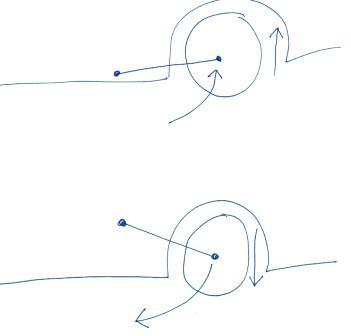
- Scan_20160214_Page_1.jpeg (8.19 KiB) Viewed 1206 times
This was the actual highered dolomite for comparison.

- IMG_3179-X2a.jpg (98.54 KiB) Viewed 1206 times
Jeroen
Re: Lowered engine mounts?
Posted: Sun Feb 14, 2016 9:05 pm
by Carledo
I have driven my Toledo like this:-
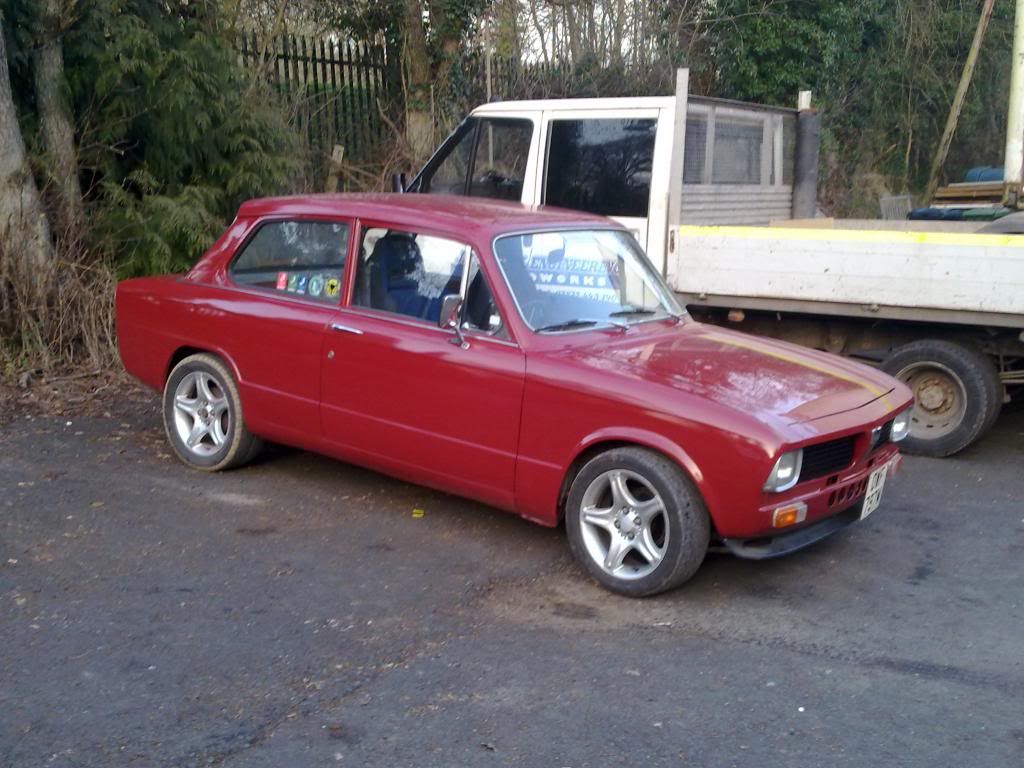
And also like this:-

Would you like to guess which way worked better?
I can understand the need for camber adjustment when lifting the front end, as simply lifting it would naturally produce positive camber which is not desireable.
Camber adjustment and why you don't lower the rear more than
Posted: Mon Feb 15, 2016 2:20 am
by gmsclassics
You asked about camber adjustment.
It is possible by inserting washers both between the subframe and the lower suspension arm, as well as between the vertical link and lower ball joint. See photos. In both cases bolt sizes need to be longer. You then need an adjustable end to the drag strut so that you have enough adjustment to get suitable suspension settings. Only really necessary in a track car, not a road car. Harder suspension bushes are also essential. A race setting can be used to keep more rubber on the raod when cornering, increase turn in, but also lose much of the self centering.
The main reason for not lowering the rear suspension more than one inch is that this would raise the rear roll centre to a point where the rear end is prone to break away - suddenly! The cure is to raise the rear tie bar chassis mounting which means it needs to go from below the floor to above, inside the car. Obviously there is the issue of cutting the floor below the rear seat and sealing this area from the exterior. I've seen it done successfully, but it is generally not permitted to change any suspension location in classic racing. Nothing that you would consider doing to a road car!
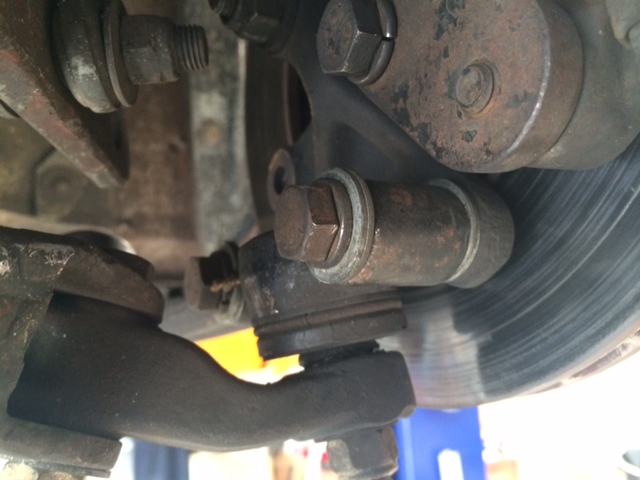
- between lower ball joint and vertcal link. Extra washer to compensate for longer bolt
- photo_1.jpg (93.93 KiB) Viewed 1178 times
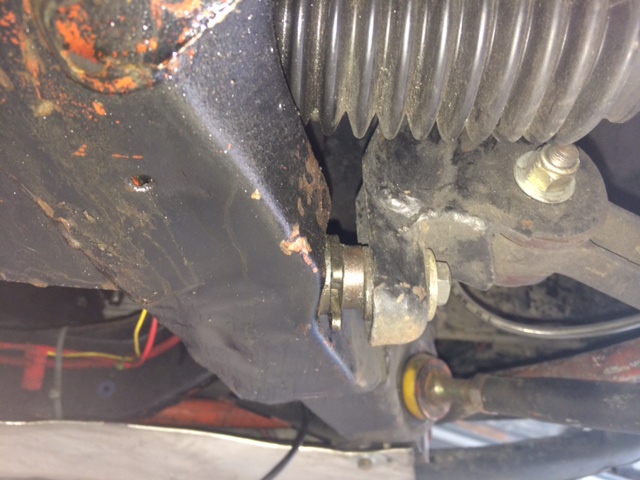
- Subframe to lower suspension arm
- photo_2.jpg (117.63 KiB) Viewed 1178 times
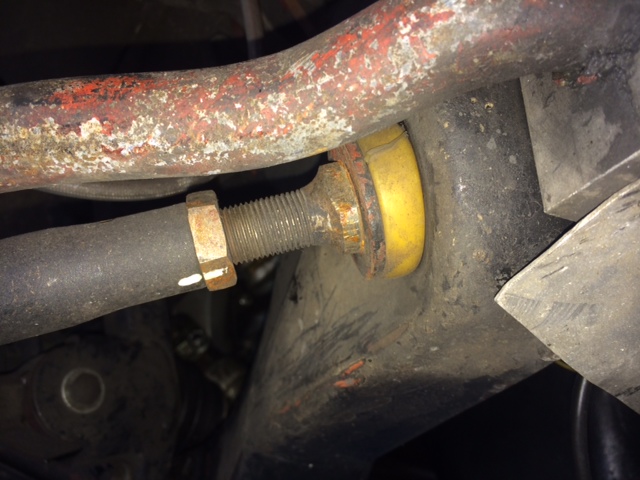
- adjustable drag link end (plus thicker sway bar). Paint marks help as a quick check to something coming undone.
- photo_3.jpg (116.86 KiB) Viewed 1178 times
Geoff
Re: Camber adjustment and why you don't lower the rear more
Posted: Mon Feb 15, 2016 7:58 am
by Boost All The Dollys
gmsclassics wrote:You asked about camber adjustment.
It is possible by inserting washers both between the subframe and the lower suspension arm, as well as between the vertical link and lower ball joint. See photos. In both cases bolt sizes need to be longer. You then need an adjustable end to the drag strut so that you have enough adjustment to get suitable suspension settings. Only really necessary in a track car, not a road car. Harder suspension bushes are also essential. A race setting can be used to keep more rubber on the raod when cornering, increase turn in, but also lose much of the self centering.
The main reason for not lowering the rear suspension more than one inch is that this would raise the rear roll centre to a point where the rear end is prone to break away - suddenly! The cure is to raise the rear tie bar chassis mounting which means it needs to go from below the floor to above, inside the car. Obviously there is the issue of cutting the floor below the rear seat and sealing this area from the exterior. I've seen it done successfully, but it is generally not permitted to change any suspension location in classic racing. Nothing that you would consider doing to a road car!
photo_1.jpg
photo_2.jpg
photo_3.jpg
Geoff
Thanks Geoff, may consider it as at the moment I'm running some serious camber up front (looks like 4-5 degrees negative) but I haven't checked it
Re: Lowered engine mounts?
Posted: Thu Feb 25, 2016 11:47 am
by Boost All The Dollys
so, although lowered mounts are out of the question, could the engine be moved back in the bay to help with weight distribution? if the propshaft was shortened and the gearbox tunnel massaged to suit?
Re: Lowered engine mounts?
Posted: Thu Feb 25, 2016 5:03 pm
by lazeruspete
theoretically yes. however you will fall foul of the sump and the subframe before you get very far I imagine. and to make any noticeable difference on a 1500(if you would see any at all) you would have to get the CoM of the engine behind the front axle centreline.

